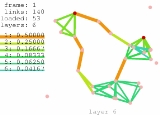
Capillary routing
Encyclopedia
In networking and in graph theory
, capillary routing, for a given network, is a multi-path solution between a pair of source and destination nodes. Unlike shortest-path routing or max-flow routing for any network topology only one capillary routing solution exists.
Capillary routing can be constructed by an iterative linear programming
(LP) process transforming a single-path flow into a capillary route. First minimize
the maximal value of the load of all links by minimizing an upper bound
value applied to all links. The full mass of the flow will be split equally across the possible parallel routes. Find the bottleneck links of the first layer (see below) and fix their load at the found minimum. Minimize similarly the maximal load of all remaining links without the bottleneck links of the first layer. This second iteration further refines the path diversity. Find the bottleneck links of the second layer. Minimize the maximal load of all remaining links, but now without the bottlenecks of the second layer as well. Repeat this iteration until the entire communication footprint is enclosed in the bottlenecks of the constructed layers.
At each layer, after minimizing the maximal load of links, the bottlenecks of the layer are discovered in a bottleneck hunting loop. At each iteration of the hunting loop, we minimize the load of the traffic over all links having maximal load and being suspected as bottlenecks. Links not maintaining their load at the maximum are removed from the suspect list. The bottleneck hunting loop stops if there are no more links to remove.
The animated image shows capillary routing footprint between a pair of nodes in a mobile ad-hoc network.
Graph theory
In mathematics and computer science, graph theory is the study of graphs, mathematical structures used to model pairwise relations between objects from a certain collection. A "graph" in this context refers to a collection of vertices or 'nodes' and a collection of edges that connect pairs of...
, capillary routing, for a given network, is a multi-path solution between a pair of source and destination nodes. Unlike shortest-path routing or max-flow routing for any network topology only one capillary routing solution exists.
Capillary routing can be constructed by an iterative linear programming
Linear programming
Linear programming is a mathematical method for determining a way to achieve the best outcome in a given mathematical model for some list of requirements represented as linear relationships...
(LP) process transforming a single-path flow into a capillary route. First minimize
Optimization (mathematics)
In mathematics, computational science, or management science, mathematical optimization refers to the selection of a best element from some set of available alternatives....
the maximal value of the load of all links by minimizing an upper bound
Upper bound
In mathematics, especially in order theory, an upper bound of a subset S of some partially ordered set is an element of P which is greater than or equal to every element of S. The term lower bound is defined dually as an element of P which is lesser than or equal to every element of S...
value applied to all links. The full mass of the flow will be split equally across the possible parallel routes. Find the bottleneck links of the first layer (see below) and fix their load at the found minimum. Minimize similarly the maximal load of all remaining links without the bottleneck links of the first layer. This second iteration further refines the path diversity. Find the bottleneck links of the second layer. Minimize the maximal load of all remaining links, but now without the bottlenecks of the second layer as well. Repeat this iteration until the entire communication footprint is enclosed in the bottlenecks of the constructed layers.
At each layer, after minimizing the maximal load of links, the bottlenecks of the layer are discovered in a bottleneck hunting loop. At each iteration of the hunting loop, we minimize the load of the traffic over all links having maximal load and being suspected as bottlenecks. Links not maintaining their load at the maximum are removed from the suspect list. The bottleneck hunting loop stops if there are no more links to remove.
The animated image shows capillary routing footprint between a pair of nodes in a mobile ad-hoc network.

